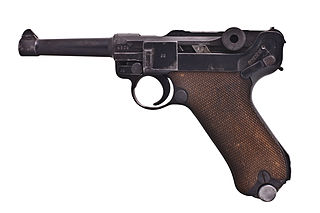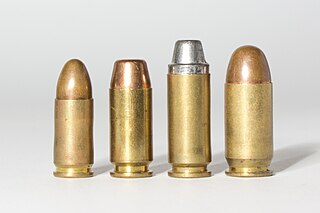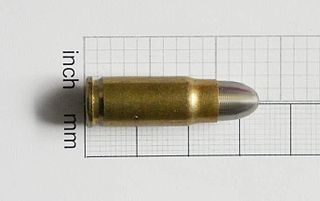The 7.62 mm caliber is a nominal caliber used for a number of different cartridges. Historically, this class of cartridge was commonly known as .30 caliber, the equivalent in Imperial and United States Customary measures. It is most commonly used in hunting cartridges. The measurement equals 0.30 inches or three decimal lines, written .3″ and read as three-line.

The Pistole Parabellum or Parabellum-Pistole, commonly known as just the Luger or Luger P08, is a toggle-locked recoil-operated semi-automatic pistol. The Luger was produced in several models and by several nations from 1898 to 1949.

Mauser, originally the Königlich Württembergische Gewehrfabrik, was a German arms manufacturer. Their line of bolt-action rifles and semi-automatic pistols was produced beginning in the 1870s for the German armed forces. In the late 19th and early 20th centuries, Mauser designs were also exported and licensed to many countries, which adopted them as military and civilian sporting firearms. The Gewehr 98 in particular was widely adopted and copied, and it is the foundation of many of today's sporting bolt-action rifles.

The Mauser C96 is a semi-automatic pistol that was originally produced by German arms manufacturer Mauser from 1896 to 1937. Unlicensed copies of the gun were also manufactured in Spain and China in the first half of the 20th century.

A semi-automatic pistol is a handgun that automatically ejects and loads cartridges in its chamber after every shot fired. Only one round of ammunition is fired each time the trigger is pulled, as the pistol's fire control group disconnects the trigger mechanism from the firing pin/striker until the trigger has been released and reset.

The 9×19mm Parabellum is a rimless, centerfire, tapered firearms cartridge.

The 7.62×25mm Tokarev cartridge is a Soviet rimless bottleneck pistol cartridge widely used in former Soviet states and in China, among other countries. The cartridge has since been replaced in most capacities by the 9×18mm Makarov in Russian service.

The M1901 Mannlicher Self-Loading, Semi-Automatic Pistol was an early semi-automatic pistol design. The Bundeswehr Museum of German Defense Technology in Koblenz has one of these specimen in its collection.

Deutsche Waffen- und Munitionsfabriken Aktiengesellschaft, known as DWM, was an arms company in Imperial Germany created in 1896 when Ludwig Loewe & Company united its weapons and ammunition production facilities within one company. In 1896 Loewe founded Deutsche Waffen- und Munitionsfabriken with a munitions plant in Karlsruhe (Baden), formerly Deutsche Metallpatronenfabrik Lorenz, and the weapons plant in Berlin. Shares that Loewe had in other gun- and ammunition plants were transferred to DWM. This included Waffenfabrik Mauser, Fabrique Nationale d'Armes de Guerre (FN) in Belgium and Waffen- und Munitionsfabrik A.G. in Budapest. The DWM was orchestrated by Isidor Loewe (1848–1910), as his brother Ludwig had died in 1886. Karl Maybach was employed by the Loewe company in 1901.

Georg Johann Luger was an Austrian designer of the famous Luger pistol and the 9×19mm Parabellum cartridge.

A handgun is a firearm designed to be usable with only one hand. It is distinguished from a long gun which needs to be held by both hands and braced against the shoulder. Handguns have shorter effective ranges compared to long guns, and are much harder to shoot accurately. While most early handguns are single-shot pistols, the two most common types of handguns used in modern times are revolvers and semi-automatic pistols, although other handguns such as derringers and machine pistols also see infrequent usage.

The 7.65×25mm Borchardt cartridge was designed by Georg Johann Luger for use in Hugo Borchardt's Borchardt C-93 pistol. It was the first successful rimless pistol cartridge.

The 9×25mm Mauser is a cartridge developed for the Mauser C96 service pistol around 1904 by DWM. Mauser pistols in this relatively powerful caliber were primarily intended for export to Africa, Asia, and South America. The 9mm Mauser Export cartridge was produced specifically for Mauser pistols and carbines made from 1904 to 1914 and then later from approximately 1930 to 1945 for submachine guns chambered for this caliber.

The .38/.45 Clerke, aka .38/.45 Auto Pistol, .45/.38 Auto Pistol, or 45/.38 Hard Head, is a wildcat semi-automatic pistol cartridge developed by Bo Clerke and introduced in Guns & Ammo in 1963.

The 7.63×25mm Mauser round is a bottleneck, rimless, centerfire cartridge, originally developed for the Mauser C96 service pistol. This cartridge headspaces on the shoulder of the case. It later served as the basis for the 7.62mm Tokarev cartridge commonly used in Soviet and Eastern Bloc weapons.

The 7.65×21mm Parabellum is a pistol cartridge that was introduced in 1898 by German arms manufacturer Deutsche Waffen- und Munitionsfabriken (DWM) for their new Pistol Parabellum. The primary developers of the pistol cartridge were firearms designers Georg Luger and Hugo Borchardt, who developed the round from the earlier 7.65×25mm Borchardt while working at DWM.

The Beretta Model 1923 pistol was a service pistol used by the Italian Army from 1923 until 1945. The M1923 was designed to consolidate the improvements of the 1915/19 model and to use the 9mm Glisenti round. However, due to the vast amount of handguns available after the end of World War I only 3000 samples, of about 10.000 produced, were purchased by the Italian Army.

The .22 TCM or 22TCM is a proprietary bottle-necked rimless cartridge created from a 5.56mm NATO / 223 Rem parent case. Developed by custom gunsmith Fred Craig and Martin Tuason, President of Rock Island Armory (RIA) Armscor. Used in the RIA M1911 pistols, and the M22 TCM bolt-action rifle. Before the cartridge was commercialized, it was called the 22 Micro-Mag. Similar concept to other bottle-necked pistol cartridges such as 7.62x25mm Tokarev, and FN 5.7x28mm. The 22TCM trades bullet mass for increased velocity and lower recoil.

The Modelo 1905 is a pistol designed by Ferdinand Ritter von Mannlicher in 1899 and originally produced in Austria as the Mannlicher Model 1901. The Mannlicher Model 1901 was an improved version of the Model 1900, both of which were produced by Österreichische Waffenfabriks-Gesellschaft. All of these models have the same basic design and operation, but minimal adjustments were made to improve each of them. The Modelo 1905 is the version of the Model 1901 that the Argentine Army purchased from Steyr in 1905. This semi-automatic pistol has a unique and elegant appearance due to the curve of the handgrip. It is single action and uses a blowback operation system to reload. Like its predecessors, the Modelo 1905 has a non-detachable magazine that can be loaded from the top with a stripper clip.

The Beretta Model 1915 or Beretta M1915 is a semi-automatic pistol manufactured by Beretta, designed by Tullio Marengoni who was the chief engineer in the company, to replace the Glisenti Model 1910 which had a complex and weak firing mechanism. It is the first semi-automatic pistol, manufactured by the company, and issued as a service pistol in Royal Italian Army during World War I. The total production of the Beretta M1915 is estimated about 15,670 during 1915-1918, and about 56,000 of Beretta M1915/1917. Some of the pistols were also used in World War II until 1945. Its open slide design later became the characteristic for other Beretta pistols such as Beretta M1923, Beretta M1934, Beretta M1935, Beretta M1951, Beretta 70, Beretta 92, Beretta Cheetah, and Beretta M9.























